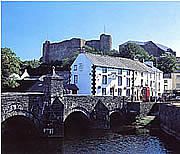Beginnings 1100-1660

Anyone approaching Haverfordwest by way of the main A40 road from the east - or from the north - is likely to focus on the castle first, a splendid ruin looming over the lower part of the town.
Barely 25 years after their conquest of England, the rapacious Norman barons established themselves in the westernmost corner of Wales. The native Welsh were cleared from large tracts of what is now Pembrokeshire and a colony of Flemings settled in their place. It was a Fleming, one Tancard or Tancred, who raised the original Haverfordwest Castle in about 1110.
Tancard chose an excellent strategic position: a precipitous rock outcrop close to the lowest fordable point on the river, the Western Cleddau, yet accessible to the sea-going vessels of his day. The original fortress may have been of wood. If so, this had been replaced by a stone castle some time before the chronicler Giraldus Cambrensis visited the place in 1188.

A town was first established under the castle’s western and northern walls, where the slope is less than vertiginous. Haverford, as it was known, was sacked by Llywelyn I in 1220 (the stronghold itself held out), but its growth was soon resumed. To the east, Bridge Street squeezed between the river and the castle rock, while High Street curved up the hill opposite the castle’s south wall. By the end of the 13th century the castle lay at the heart of a thriving borough, among the most populous and most important in Wales.
Eleanor of Castile, wife of Edward I and one of the royal holders of the lordship of Haverford, spent a fortune on the castle. It defied an attack in 1405 when the town was burned again, on this occasion by a French force allied to Owain Glyndwr. Fifty years later the castle was in decay.
During the English Civil War the town and castle changed hands together, according to the fortunes of war. The castle was by that time of very minor military significance. Nevertheless Cromwell later ordered that it be dismantled. Compliance by the town authorities was at best half-hearted and the castle was allowed to crumble away. No doubt it became a source of limestone and sandstone for generations of builders, for rubble is the material of which the town is largely composed.
The walls and towers that survive are probably Queen Eleanor’s work. In what was once the outer ward of the castle is a bleak 19th century prison, now the County Record Office; also the small but absorbing Haverfordwest Town Museum occupying the former prison governor’s house.

